If you’re looking for budget-friendly home improvement ideas, you’re not alone. A few smart updates can make a big impact on your home without draining your savings.
Looking for budget-friendly home improvement ideas that can transform your home without emptying your wallet? You’re in the right place.
Did you know that the average kitchen remodel costs $25,000, while a bathroom renovation can set you back $10,000 or more?
However, creating a luxurious-looking home doesn’t require breaking the bank. In fact, affordable home renovations can deliver the same high-end appearance when you know the right tricks and techniques. Many homeowners achieve magazine-worthy results at a fraction of the typical cost.
Fortunately, transforming your space into something that looks expensive without the premium price tag comes down to smart planning, strategic material choices, and professional design secrets.
Ready to give your home an upscale makeover without the upscale budget? This guide will show you exactly how to create that expensive look while keeping your wallet happy.
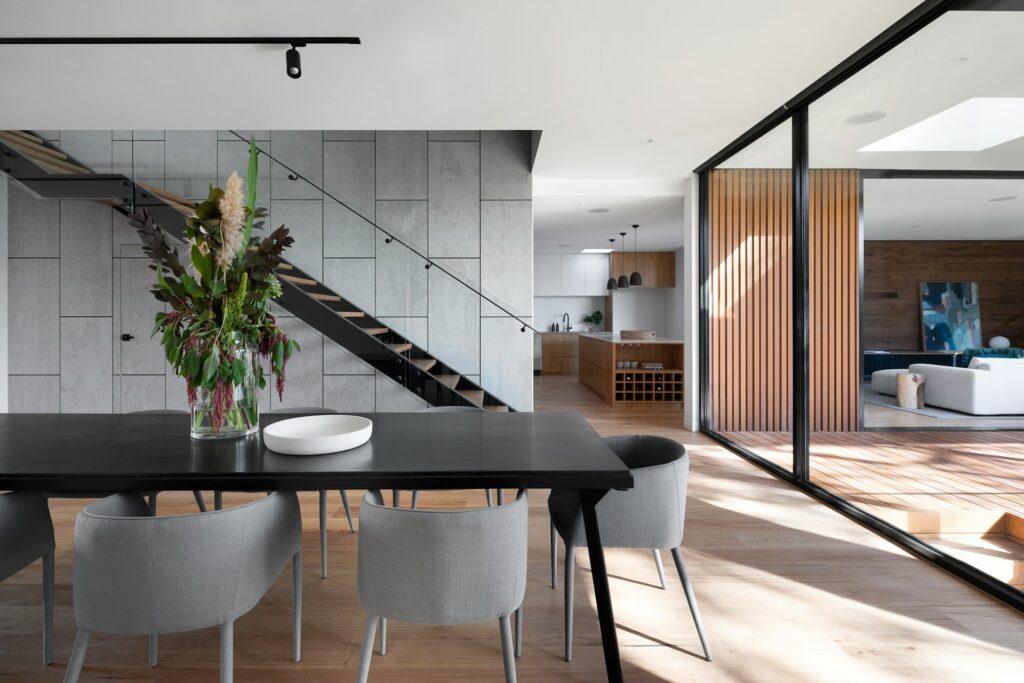
Plan Your High-End Look on a Budget
Starting a successful renovation begins with meticulous planning. Initially, focus on creating a solid foundation for your project before picking up any tools or materials.
Set clear renovation goals
Begin by defining your specific vision and goals. Consider whether you’re renovating to increase property value or enhance living comfort. Create a list of must-have features and prioritize them based on their impact on your daily life. Additionally, evaluate your neighborhood to determine which projects offer the best return on investment.
Research luxury design trends
Focus on timeless designs rather than fleeting trends to maintain long-term value. Specifically, explore budget-friendly alternatives that mimic expensive materials, such as laminate flooring that resembles hardwood or quartz countertops that imitate marble. Furthermore, consider these key elements for your renovation:
- Define your design esthetic (modern, classic, or eclectic)
- Explore material alternatives and finishes
- Identify focal points for maximum impact
- Research lighting options that enhance luxury appeal
Create realistic timeline
Developing a realistic timeline ensures smooth project execution. Small updates typically require 2-3 weeks, whereas major renovations can extend several months. Furthermore, factor in these crucial timeline elements:
Start your planning phase 4-8 weeks before construction. Allow 2-6 months for thorough design processes, with single rooms needing about two months and multi-room projects requiring 4-6 months. Additionally, add a two-month buffer for unexpected delays or emergencies.
Consider ordering materials well in advance, particularly for custom items. Semi-custom cabinetry needs 2-3 months for delivery, whereas fully customized pieces might take 3-4 months. Consequently, plan your material orders strategically to avoid construction delays.
Choose Materials That Look Expensive
Selecting the right materials makes all the difference between an average renovation and one that exudes luxury. First thing to remember, high-end appearances often stem from smart material choices instead of astronomical budgets.
Compare high-end vs budget materials
Above all, understanding the characteristics of premium materials helps identify quality alternatives. Natural stone, hardwood, and custom cabinetry create stunning spaces but often come with steep price tags. Important to realize, many modern alternatives offer similar esthetics together with improved durability and easier maintenance.
Consider these material comparisons:
- Marble vs. porcelain tiles: Porcelain tiles now replicate marble’s elegant veining at one-third the cost
- Solid hardwood vs. engineered wood: Engineered options provide durability at USD 3.00 per square foot
- Natural stone vs. quartz countertops: Quartz delivers comparable beauty with enhanced stain resistance
Find affordable alternatives to luxury items
Under those circumstances where premium materials stretch beyond your budget, numerous alternatives deliver impressive results. Luxury vinyl flooring, priced between USD 2.00 to USD 7.00 per square foot, offers remarkable durability and authentic wood-like appearance 8. Moreover, laminate countertops have evolved significantly, providing realistic stone patterns with superior scratch resistance.
For wall treatments, peel-and-stick marble contact paper transforms countertops and backsplashes at minimal cost. On balance, faux leather upholstery presents an ethical alternative that maintains durability in high-traffic areas. In essence, modern manufacturing techniques have produced alternatives that closely mimic premium materials while offering practical advantages.
Glass elements add sophistication but often prove costly and fragile. In light of this, acrylic serves as a practical substitute, delivering similar transparency with enhanced durability. To put it differently, exposed brick walls create character but demand significant investment – faux brick panels provide comparable visual impact with simpler installation.
Focus on High-Impact Areas First
Making smart choices about which areas to renovate first maximizes your budget’s impact. Primarily, focusing on spaces that catch immediate attention creates the most significant impression of luxury.
Identify visible focal points
The entryway serves as your home’s first impression, making it a crucial starting point for affordable home renovations. Subsequently, updating elements like house numbers, outdoor lighting, and a letterbox creates lasting impact. A well-designed entrance area sets the tone for the entire home experience.
Architectural details draw attention naturally. Accordingly, adding crown molding or new baseboards elevates rooms with a more finished, luxurious appearance. Statement lighting fixtures energize spaces while creating visual focal points. These strategic upgrades direct attention to your home’s best features.
For exterior focal points, a landscaped walkway with perennial plants adds natural beauty and texture. Outdoor architectural lighting highlights unique features while increasing charm and security. These improvements boost curb appeal without requiring extensive renovation work.
Prioritize guest-facing spaces
Guest-facing areas deserve special attention since they receive the most visibility and use. Notably, about 2 in 5 homeowners exceeded their home improvement budget, making it essential to prioritize spaces strategically.
The kitchen, often considered the heart of the home, benefits from targeted improvements:
- Ample storage solutions for organization
- Updated light fixtures for enhanced ambiance
- Modern hardware for a fresh look
- Energy-efficient appliances for dual benefits
Guest bathrooms present opportunities for impactful changes through:
- Strategic lighting placement
- Updated fixtures and faucets
- Smart storage solutions
- Modern vanity updates
As a result of proper planning, these high-traffic areas become both functional and esthetically pleasing. Similarly, creating welcoming guest rooms with proper lighting and comfortable amenities ensures visitors feel valued.
Remember that focusing on guest-facing spaces not only enhances daily living but also contributes significantly to property value. These areas typically offer the highest return on investment, making them ideal candidates for affordable home renovations that look expensive.
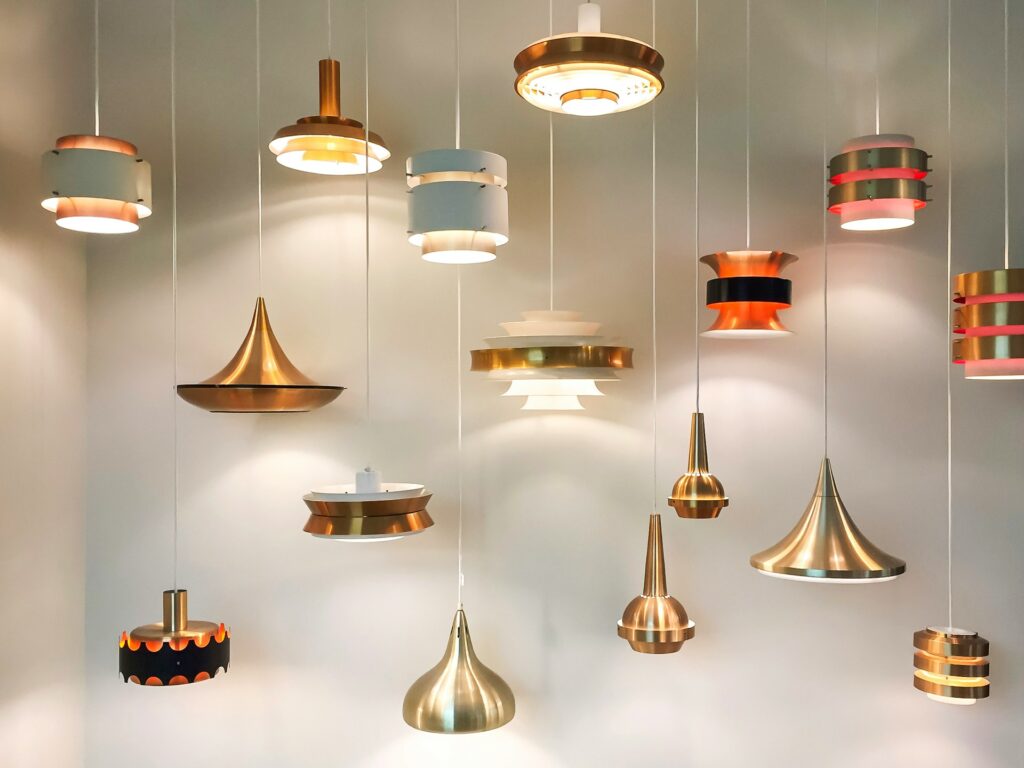
Master the Art of Strategic Upgrades
Small changes often create the biggest impact in affordable home renovations. Strategic upgrades in key areas can dramatically enhance your home’s appearance without excessive spending.
Update hardware and fixtures
Coordinating hardware finishes throughout your space creates a cohesive, luxurious look. Primarily, focus on replacing mismatched accessories with new, coordinating pieces in bathrooms and kitchens. Matte black hardware offers a sleek, contemporary appearance that ages gracefully. Generally, items like door handles, drawer pulls, and cabinet knobs cost between USD 2.00 to USD 10.00 per piece.
Door hardware deserves special attention, as new handles can increase both security and style. Steel doors with modern hardware provide excellent insulation and offer a 93.3% return on investment. Indeed, replacing outdated hardware with sleek, contemporary designs immediately elevates any space’s appearance.
Add architectural details
Crown molding stands as one of the most effective ways to add sophistication to any room. Lightweight polyurethane ceiling medallions, available in various sizes, can be painted to match your décor while adding visual interest around light fixtures. Soon, these simple additions transform plain ceilings into striking focal points.
Board-and-batten wall treatments create eye-catching retreats in bedrooms and living spaces. Nevertheless, proper planning remains crucial – measure carefully and maintain consistent spacing between panels. For optimal results, set wall panels 8 inches from the ceiling and 10 inches from the floor.
Install statement lighting
Statement lighting serves as jewelry for your rooms, drawing eyes upward while emphasizing ceiling height. Consider these impactful lighting options:
- Chandeliers and pendant lights for dining areas and entryways
- Wall sconces for bedrooms and hallways
- Under-cabinet lighting for kitchen workspaces
- Pin lighting for artwork and photographs
Ultimately, proper lighting transforms spaces through layered illumination. Statement pieces should measure 1/3 to 1/2 the length of nearby furnishings. Additionally, incorporate dimmable options to adjust ambiance throughout the day.
For maximum impact, combine ambient, task, and accent lighting in each room. Occasionally, plug-in or battery-operated sconces offer elegant solutions without requiring electrical work. Hence, even renters can enjoy the benefits of sophisticated lighting design.
Use Professional Design Tricks
Professional designers possess unique tricks that transform ordinary spaces into extraordinary ones. Primarily, these techniques focus on creating depth, interest, and sophistication through thoughtful combinations of elements.
Layer textures and materials
The art of layering textures creates visual depth and tactile interest in any room. Mix rough and smooth surfaces to achieve a balanced, sophisticated look – consider pairing sleek leather with chunky knit throws or smooth glass with rough stone. During the layering process, incorporate these texture combinations:
- Natural materials like wood, stone, and rattan for warmth
- Soft fabrics such as velvet, cotton, and linen for comfort
- Metallic finishes to add subtle glamor
- Glass elements for reflection and depth
Evidently, contrasting textures make each element stand out while working harmoniously. Therefore, pair shiny surfaces with matte finishes or combine hard materials with soft textiles. For instance, place a stone sculpture on a glass table to highlight both materials’ unique qualities.
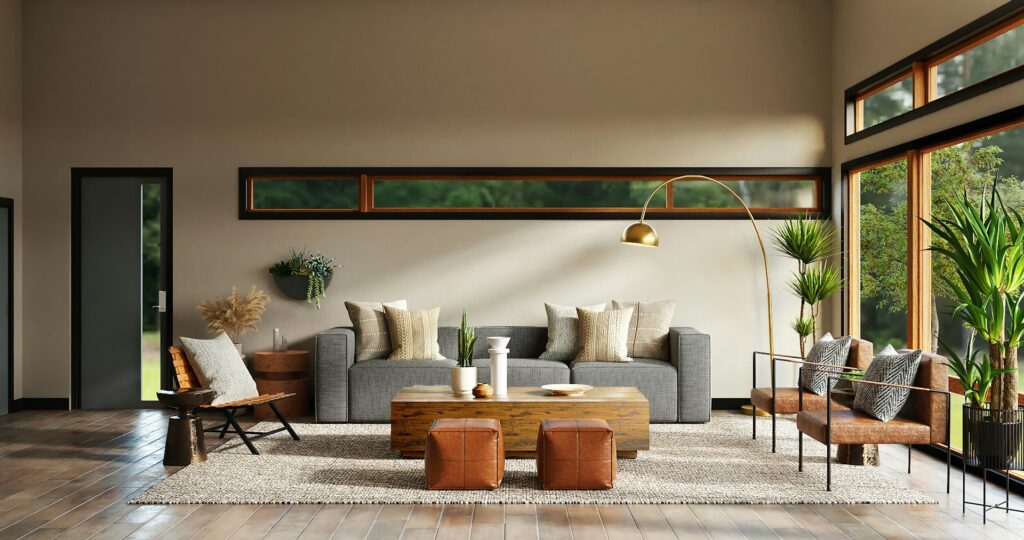
Create visual balance
Visual balance emerges from thoughtful furniture placement and proper proportions. Thus, ensure the visual weight of furniture on one side of the room matches the opposite side. Alternatively, extend design elements along an axis line from the focal point to create symmetrical appeal.
Natural light plays a crucial role in balance. Incorporate these lighting layers:
- Ambient lighting through chandeliers and ceiling fixtures
- Task lighting with desk and reading lamps
- Accent lighting using wall sconces and picture lights
Although symmetry creates formal spaces, asymmetrical arrangements can feel more relaxed while maintaining balance. Nonetheless, keep spacing consistent and edges aligned for a polished look.
Add custom touches
Custom elements elevate spaces from basic to extraordinary. Built-in features like bookcases, window seats, or storage solutions add architectural interest while maximizing functionality. Otherwise, consider these personalization options:
Picture-frame molding on walls draws attention to specific areas. Simultaneously, crown molding and baseboards add refined architectural detail. For an instant upgrade, embellish light fixture attachments with lightweight ceiling medallions.
Natural elements bring organic texture and life to rooms. Plants and greenery act as the final touch in well-designed spaces. Additionally, incorporating vintage or heirloom pieces adds character and creates unique focal points.
For window treatments, custom drapes or Roman shades provide privacy while introducing pattern and softness. Furthermore, quality upholstery in natural fabrics like linen or cotton creates an inviting atmosphere. These thoughtful additions transform standard rooms into personalized retreats that reflect sophisticated taste without excessive cost.
Conclusion
Luxurious home renovations need not drain your savings account. Smart planning, strategic material choices, and professional design techniques create upscale results without premium costs.
Affordable alternatives like engineered wood, quality laminates, and modern vinyl materials deliver high-end appearances while staying budget-friendly. Focusing renovations on high-impact areas, especially guest spaces and focal points, maximizes the value of every dollar spent.
Strategic upgrades through coordinated hardware, architectural details, and statement lighting transform ordinary spaces into sophisticated environments. Professional design elements such as balanced textures, thoughtful lighting layers, and custom touches add the final polish that makes your home stand out.
Remember, successful renovations stem from careful planning rather than excessive spending. Start with clear goals, choose materials wisely, and implement design tricks strategically. These proven approaches ensure your home renovation projects deliver expensive-looking results while protecting your budget.
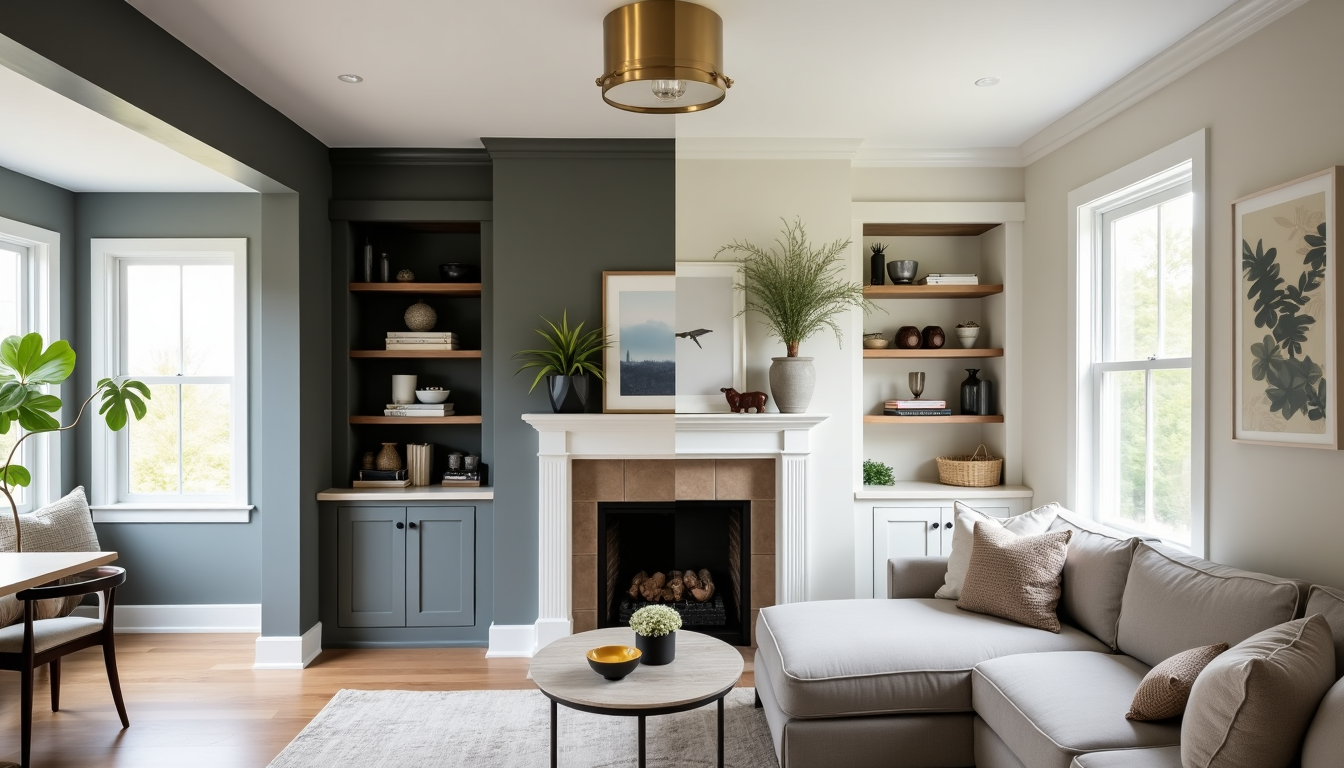
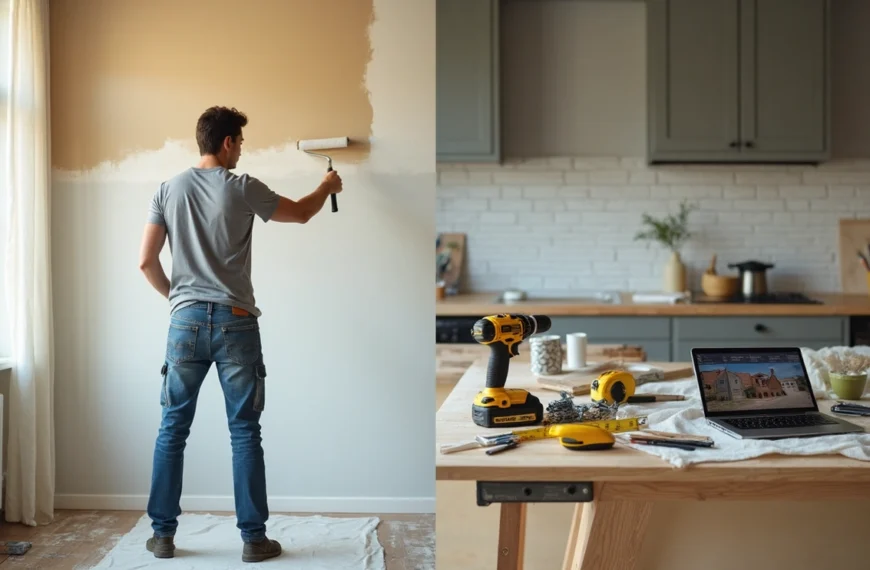
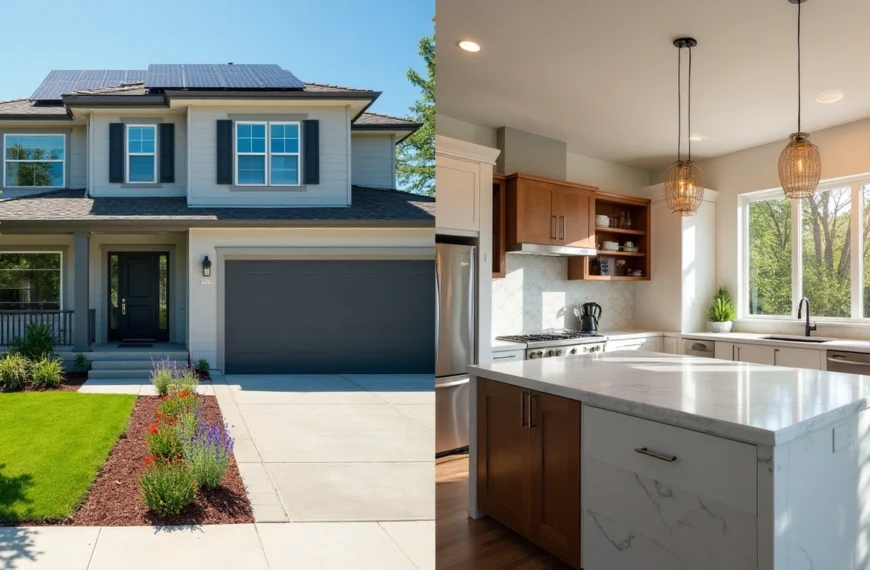
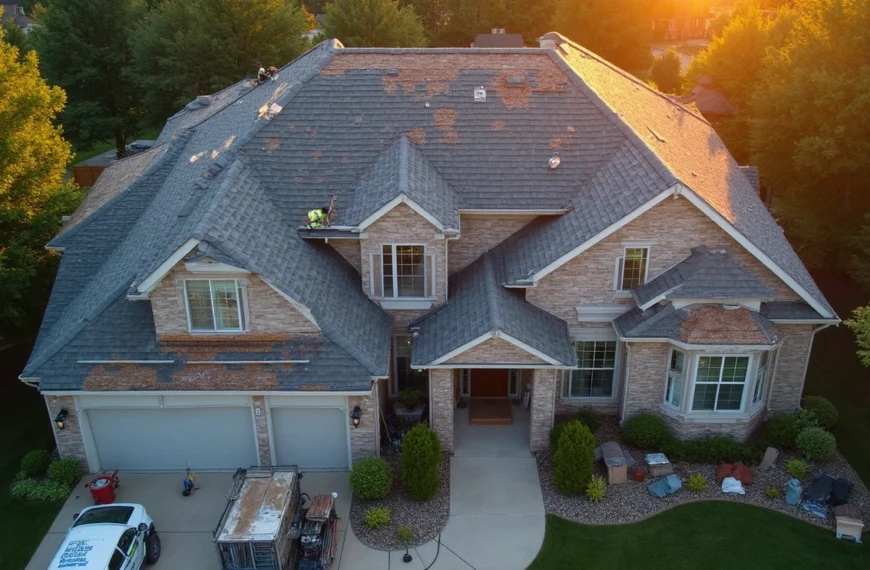





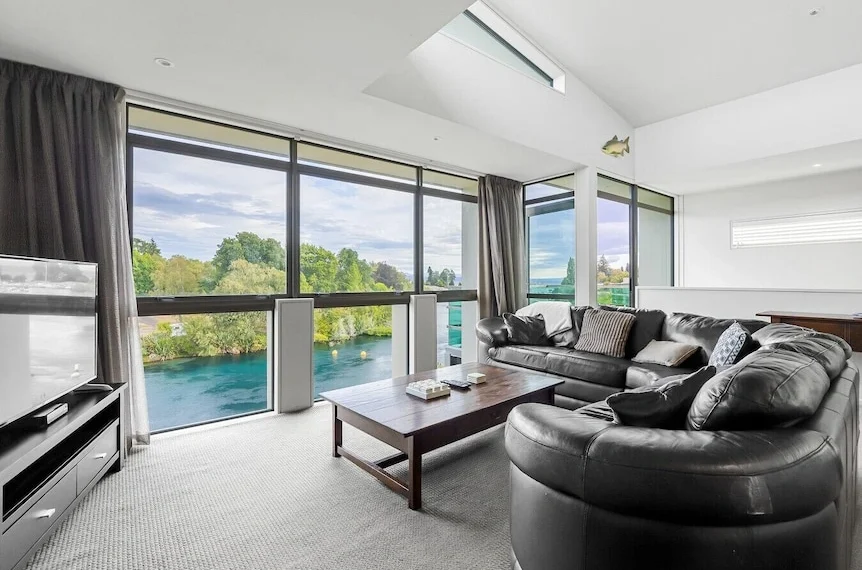



![No Win No Fee Lawyers: The Hidden Truth About Settlement Cuts Legal representation through no win no fee lawyers gives clients a way to fight cases without paying anything upfront. Many clients don't know that these services take a big chunk of money after winning the case. Lawyers usually take 25% to 40% of what you win as their contingency fee. The amount lawyers take from settlements can add up fast. A $100,000 settlement means your attorney gets $30,000 if they charge a 30% fee after winning your case. Your solicitor's cut might be £10,000 from a £30,000 compensation award, based on your agreement percentage. This payment model stays pretty much the same for no win no fee lawyers in different places, though percentages can change. This piece breaks down what you need to know about contingency fee deals. You'll learn about standard fee ranges, extra costs beyond the basic fee, and times when this payment setup might not work in your favor. Smart clients should think over these money matters before signing up with a lawyer to make better choices about their legal help. What No-Win No-Fee Really Means Image Source: Express Legal Funding A no-win no-fee arrangement, also called a Conditional Fee Agreement, changes the way people get legal help. This payment approach removes the need to pay legal fees upfront and creates a partnership between clients and their attorneys. How contingency fees work No-win no-fee agreements are based on contingency fees. Lawyers get paid only when they win compensation for their clients. Most lawyers take between 25% and 40% of the final amount, based on how complex the case is and where it's filed. Lawyers take their cut after winning the case. To name just one example, see a case where a lawyer wins £30,000 in compensation with a 33% fee - they would receive £10,000. On top of that, some law firms use sliding scales where they charge less for quick settlements and more if the case goes to trial. The law requires a written agreement before any work starts. This paperwork spells out the lawyer's percentage, what costs you'll need to cover, and other key details. What happens if you lose the case The meaning behind "no-win no-fee" is clear - losing your case means you won't pay your lawyer anything. All the same, you should know about a few money-related details. You won't owe your lawyer when you lose, but some deals might make you pay for court fees, expert witnesses, or other case expenses. The other side could also ask you to pay their legal costs. Many lawyers suggest getting "After Event" insurance to protect their clients. These policies cover any costs if you lose your case, which makes the no-win no-fee setup much safer. Why lawyers offer this model Lawyers want to make legal help available to more people, so they offer these payment plans. This setup helps people who don't have much money take legal action when they have valid claims. The payment structure motivates lawyers to work hard. They only get paid by winning cases, which pushes them to get the best results possible. Lawyers carefully assess each case before taking it on a no-win no-fee basis. They usually accept cases that have a good chance of winning, since they put in lots of time and resources without any guaranteed payment. The Real Cost: How Much Do Lawyers Take from a Settlement Image Source: Greiner Law Corp. The true cost of no-win no-fee legal representation becomes clear once we look at contingency fees. Many clients feel surprised to see a big chunk of their settlement checks going to their attorney's fees. Typical percentage ranges (25%–40%) No win no fee lawyers typically ask for 25% to 40% of the total settlement amount. Personal injury attorneys usually take 33.3% (one-third) of the awarded compensation[101]. Lawyers and clients agree on this percentage before any work starts on the case. Several factors shape the final percentage. Your chances of winning, case complexity, and the work to be done play key roles in determining the attorney's cut. Some areas have laws that cap the maximum contingency fees for specific types of cases. Sliding scale based on case complexity Law firms often use a tiered fee system that changes with the case stage and complexity. This scale rewards quick settlements while paying attorneys fairly if more work becomes needed. The fee might start at 30% if the case settles before lawsuit filing. This number could climb to 35% after filing or reach 40% if the case goes to trial. Law firms often group cases by complexity: 10%-20%: Simple cases with straightforward settlements 25%-35%: Typical personal injury cases 35% and above: Complex cases requiring extensive resources Examples of payout breakdowns These ground examples show how fees affect settlements: A $15,000 settlement with a 33.3% contingency fee.pdf) puts $5,000 in the attorney's pocket, leaving $10,000 for the client. Similarly, from a $100,000 settlement with a 33% fee, the attorney gets $33,000 while the client receives $67,000[102]. Complex cases tell a different story. A $100,000 settlement with a 30% fee plus $5,000 in extra costs leaves $65,000 for the client after all deductions. These fees substantially change the client's final payout. Hidden Costs You Might Not Expect Image Source: Nelson Personal Injury Lawyers Beyond percentage-based fees, clients often feel surprised by extra costs that can reduce their final compensation by a lot. These hidden costs show up in the fine print of no-win no-fee agreements. You should think over these details before signing. Court filing and expert witness fees Legal proceedings come with unavoidable court filing fees. These charges differ by jurisdiction. They usually range from $30 for small claims to several hundred dollars for complex civil lawsuits. Expert witnesses can be expensive, with hourly rates ranging from $150 to $1,000 based on their credentials and testimony complexity. Expert witnesses charge more for court appearances than consultation work because of added pressure and prep time. Clients might still need to pay experts for their prep work even if the case settles before trial. Medical report and investigation costs Medical documentation is a vital part of many legal claims. These costs include fees to release medical records, create specialized reports, and prepare documents. Investigation costs cover evidence gathering, police reports, witness interviews, and other fact-finding work needed to build a strong case. Of course, some firms say they'll cover these expenses upfront, but clients don't completely avoid these costs. When these costs are deducted from your compensation Law firms take these expenses from the settlement amount before they calculate their percentage fee, though each firm handles this differently. Some lawyers subtract these costs after figuring out their contingency fee, which changes how much money clients end up with. Most firms pay case-related costs during the process and get their money back from the settlement. The defendant usually pays most simple legal costs and disbursements in successful cases, but not always everything. Insurance protects clients from costs in unsuccessful claims at many law firms, but this protection isn't guaranteed. Clients should review their agreements carefully since they might still need to pay specific expenses even if they lose their case. When No-Win No-Fee Might Not Be the Best Option Contingency fee arrangements give many people access to justice. However, this payment model doesn't always work in a client's best interests. Knowing these limitations helps clients make better decisions about their legal representation. Cases with unclear liability Lawyer no win no fee arrangements work best in cases where fault is clear. We assessed the probability of success before taking contingency cases. Lawyers might turn down cases if there isn't enough evidence of the other party's negligence or if liability isn't certain. Cases with multiple responsible parties create more challenges. The situation gets complicated fast when several parties share liability. Lawyers are less likely to take these cases on contingency. They need to be confident they can prove the other party's negligence before accepting a case. Low-damage or low-payout claims Small claims often don't work well with the contingency model, even with real injuries. Cases that have minimal injuries or limited financial damages might not bring enough compensation to cover legal costs. The potential settlement needs to be big enough to pay for investigations, witness interviews and court fees. Personal injury lawyers often turn down cases where the "compensation potential" is too small. This doesn't mean the claim isn't valid - it just means the economics don't add up for a contingency arrangement. Situations where hourly billing may be better Hourly billing has clear advantages in certain cases. Clients see exactly what they're paying for - every hour worked and task completed. This model works well for cases that need lots of attention but don't have clear financial outcomes. Complex litigation with opposing parties works better with hourly billing and a retainer fee. Clients have more control over their case and don't feel pressured to settle quickly. Cases that need extensive preparation but have uncertain outcomes fit the hourly model better. Lawyers can spend the time needed without worrying about contingency limits. This approach often leads to better representation, especially for complex legal issues that need special expertise. Conclusion Understanding the Full Picture Before You Sign No-win no-fee arrangements offer legal representation without upfront costs. Of course, this seems attractive at first glance. In spite of that, you need to think about how these agreements can affect your final compensation. Legal fees usually range from 25% to 40% of your settlement - but that's just the start. You'll face more deductions like court filing fees, expert witness costs, and charges for medical documentation. What looks like a "free" service ends up taking a big chunk of your compensation to cover legal expenses. These arrangements work best in specific situations - cases with obvious liability, substantial damages, and solid evidence. If you have a low-value claim or complex liability issues, traditional hourly billing might serve you better. Without doubt, you should ask for clear explanations of all possible costs before signing anything. Read the fine print closely, especially when you have to deal with expenses in unsuccessful cases. Ask to see sample settlement breakdowns that show all deductions. This helps you picture what you might actually take home. Your choice to go with a no-win no-fee arrangement depends on your situation. This model helps if you don't have money to pursue valid claims. But if you have a strong case and enough funds, other fee structures might let you keep more of your compensation. Whatever payment model you choose, knowing exactly how much lawyers take from settlements helps you make better decisions. This knowledge lets you approach legal representation with real expectations and better control over your money. FAQs Q1. What percentage of a settlement do no-win no-fee lawyers typically take? No-win no-fee lawyers typically charge between 25% to 40% of the final settlement amount as their contingency fee. The exact percentage often depends on the complexity of the case and the stage at which it is resolved. Q2. Are there any hidden costs in no-win no-fee arrangements? Yes, there can be additional costs beyond the lawyer's percentage fee. These may include court filing fees, expert witness costs, medical report expenses, and investigation costs. These expenses are usually deducted from the settlement amount before or after the lawyer's fee is calculated. Q3. What happens if I lose my case in a no-win no-fee arrangement? If you lose your case, you generally won't have to pay your lawyer's fees. However, you might still be responsible for certain expenses like court costs or the opposing party's legal fees. Many lawyers offer insurance to protect clients from these potential costs in case of an unsuccessful claim. Q4. When might a no-win no-fee arrangement not be the best option? No-win no-fee arrangements may not be ideal for cases with unclear liability, low-value claims, or complex legal issues requiring extensive preparation. In these situations, traditional hourly billing might be more appropriate and potentially more cost-effective for the client. Q5. Can I negotiate the percentage a lawyer takes from my settlement? Yes, the contingency fee percentage is often negotiable. It's typically agreed upon and formalized in writing before the lawyer begins working on your case. Don't hesitate to discuss the fee structure with your lawyer and ask for a detailed breakdown of potential costs and deductions.](https://consumersweek.com/wp-content/uploads/2025/06/No-Win-No-Fee-Lawyers-The-Hidden-Truth-About-Settlement-Cuts-870x570.webp)

